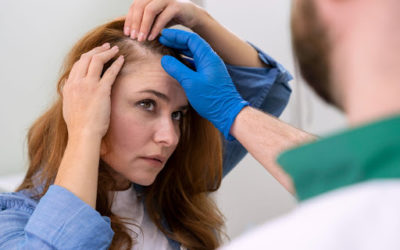The progression of genetic hair loss is a miniaturization process that plays out in each separate hair follicle, but in a pattern predetermined by inherited traits.
For most of us, at around age 20 the amount of hair we have on our head begins to decrease. That is in terms of hair count not weight. For some, this is a subtle process they may not notice for decades. Women benefit from the buffering effect of estrogen and progesterone that increases hair quality in their 20s and 30s. This is why many women don’t begin to notice the effects of hair loss until they are pre-menopausal and undergo a change in their hormone profile.
For men, this process is generally noticeable much earlier, as they lack the assistance of hair volume increasing hormones and can be subject to more aggressive patterns of balding via androgen sensitivity.
What governs the process of genetic hair loss?
- You need to have the gene for hair loss which gives you a genetic sensitivity to certain androgens. Androgens are any steroid hormone that regulates the development and maintenance of male characteristics.
- Testosterone is converted into DHT (dihydrotestosterone) by the enzyme 5a-R. The amount of 5a-R varies from person to person and even follicle to follicle which is why specific patterns of balding are so different.
- DHT kicks off the process of miniaturization.
- Each time the hair goes through a growth cycle (5-7yrs) it grows back smaller and smaller.
What does the miniaturization process look like as your hair cycles through growth phases?
- The diameter of the hair shaft decreases. Each hair gets thinner
- The thinner the hair gets the less color it has. The follicle imbeds less melanin into the hair shaft.
- The hair gets shorter. The growth phase time shrinks and there are not as many active stem cells in each follicle.
- The follicle and hair shaft shrink. Once the hair shrinks to around 50% of its original size the chances it will respond positively to treatment is vastly reduced. This is the key reason why it is so important to start treatment as early as possible.
This is a very quick breakdown of a complicated process but one that can be managed if treatment is started early. To be clear, there is no cure for genetic hair loss, but there are a wide variety of treatment options that can yield positive results.




